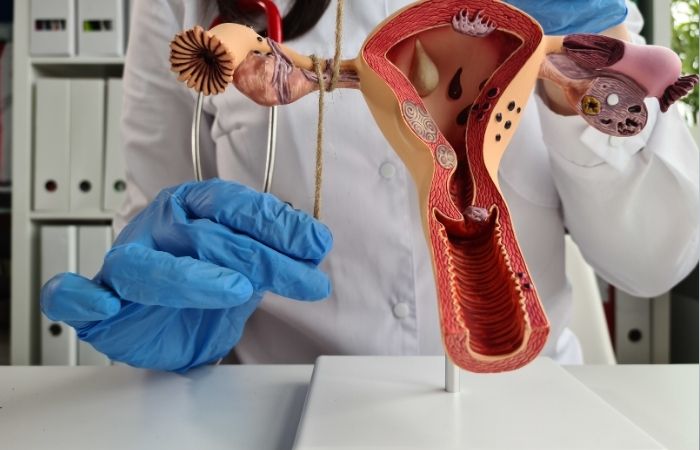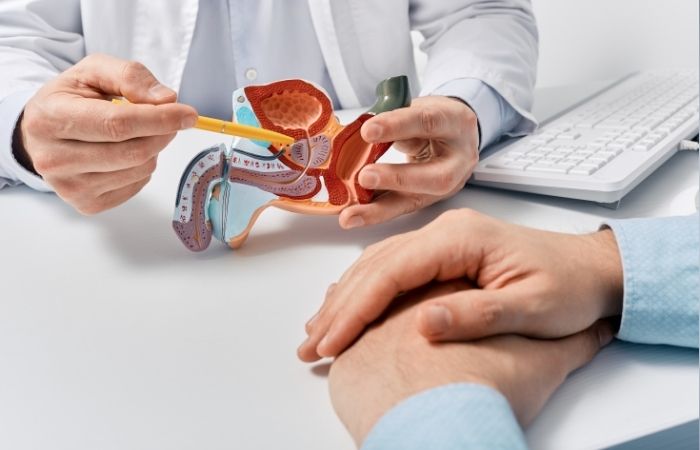7 STIs That Harm Male Fertility and How to Prevent Them
The Connection Between Sexually Transmitted Diseases and Fertility
The consequences of sexually transmitted diseases on fertility for both sexes can be severe and long-lasting. These diseases have subtle ways in which they destroy the reproductive system, making conception more difficult or impossible if left unattended. To protect reproductive health, it is necessary to understand processes and unique dangers for both sexes.
How Sexually Transmitted Diseases Affect Fertility in Women
The reproductive system is more prone to infection and damage in females, hence increasing the likelihood of infertility. Sexually transmitted diseases affect female fertility in the following ways:
Pelvic Inflammatory Disease
The serious sexually transmitted diseases - chlamydia and gonorrhea, if left untreated, may result in Pelvic Inflammatory Disease commonly called PID. Ovarian, fallopian tube and uterine inflammation and scarring result. The Fallopian Tubes can become blocked by the scarring and thus the egg and sperm may not be able to meet. Ectopic pregnancies, where a fertilized egg implants itself somewhere other than the uterus, can happen under extreme conditions.
Cervical HPV Damage
Sometimes, cervical cancer develops when the human papillomavirus causes abnormal changes in the cervix cells. These surgical and radiation treatments of the cervical cancer heavily influence the hormone secretion and/ or relicts scars to the reproductive organs of woman.
Blocked Fallopian Tubes
Tubal blockages and hydrosalpinx are sexually transmitted diseases associated with the failure of conception through natural methods or even with the assistance of in vitro fertilization. The latter provides embryos with an unfavorable environment and the tubes are blocked.

The Effects of Sexually Transmitted Diseases on Male Fertility
Although most of the sexually transmitted diseases primarily affect women, if left untreated, men may also suffer from serious reproductive problems. Some of the common effects are as follows:
Epididymitis
Epididymitis is a disease where the epididymis, an organ responsible for storing and transporting sperm, gets inflamed. Infections such as chlamydia and gonorrhea cause this. This disease can block the passage that discharge sperm.
Urethral Blockages
The urethra may become blocked due to scarring from chronic or serious infection; this prevents semen from flowing freely and may result in reduced sperm count. Certain sexually transmitted diseases, such as HIV or untreated syphilis, may affect sperm quality and count generally. Now, it is more difficult for sperm to fertilize an egg due to these changes.
Prostatitis
Prostatitis, an infection of the prostate, medical affects seminal fluid quality, affecting sperm function. HIV and Fertility: HIV impacts fertility by causing a decrease in testosterone levels, thus reducing sperm production. Moreover, it would dampen the immune systems and disrupt normal hormone balance; although HIV medicines that save lives might also have some side effects. May make it even harder to get pregnant.

Common Risks and Challenges
Indirect effects on fertility may also be seen in both sexes due to untreated STDs:
- Increased Risk of Co-Infections: The reproductive system suffers another jolt when the infection with one sexually transmitted disease increases the chances of acquiring another.
- Chronic Infections: Chronic infections stimulate the immune system, which responds with autoimmune reactions, further complicating fertility.
- Psychological Damage: Untreated STDs also take a psychological toll, as living with an untreated STD can have negative effects on hormone balance and reproductive health.
Order Now $119.00 $294.00 Check Your STD Status in Minutes
Test at Home with Remedium
6-in-1 STD Test Kit




For all 6 tests
Asymptomatic STDs: A Quiet Danger
One of the most alarming aspects of these diseases is that most STD infections often do not exhibit symptoms for a long period of time. During this time, the infected individual may be completely unaware that the disease is still causing damage to the reproductive system. According to the CDC, as many as half of gonorrhea cases and 70% of chlamydia cases are asymptomatic.
Most people who have herpes virus never notice any symptoms, yet they are infecting others all their lives.
As many STDs are silent, regular testing is important, even when there are no symptoms.
How to Protect Your Fertility
Prevention of STDs and Related Consequences
Prevention of STDs, and its related consequences of infertility, first begins with taking responsibility for one's own reproductive health. If practiced consistently, the following actions will greatly reduce the risk of infection, minimize damage, and ensure early treatment should an STD be diagnosed.
Regular Testing for Sexually Transmitted Diseases
The foundation of fertility preservation is regular testing. Since most STDs do not always have symptoms, testing regularly can help in the early detection of such infections before irreparable damage may occur.
Frequency of Testing
It is suggested that you get tested every year if you are sexually active. If you engage in high-risk behaviors or have multiple partners, you may want to consider testing every three to six months.
Home Test Kits for Pregnancy
You can test for infections discreetly with these kits, and you will not have to go to a clinic for this purpose. They are convenient and private. If you like to keep your testing in private or do not have easy access to healthcare facilities, they are the best options for you.
No Delay in Treatment and Complete Recovery
Treatment should be started as soon as possible after the diagnosis of an STD to avoid complications.
- Follow all instructions as prescribed.
- Never stop taking an antibiotic or antiviral medicine, even if you start to feel better during the course of treatment. If you stop your medication too soon, you run the risk of the infection staying or becoming resistant to treatment.
- Test and treat your partner(s) simultaneously to avoid reinfection. Communication that is open and honest is effective crisis management.
Make Sexual Ecnounters Safe
These methods include dental dams and condoms, which are some of the best methods for the protection of fertility and prevention of sexually transmitted diseases. Whenever there is going to be some sort of sexual contact—oral, anal, or vaginal—there should always be protection. Properly used condoms can strongly reduce the risk of acquiring sexually transmitted infections, like chlamydia, gonorrhea, and HIV.
Pre-Exposure Prophylaxis (PrEP)
This is a medication that can give added protection against HIV infection for individuals who are at high risk of getting infected.
Vaccination
Prevention of illnesses that may affect fertility is far easier with vaccines for hepatitis B and human papillomavirus.

Get Informed!
Know the Risks
The following information introduces the STDs, effects on fertility, and a description of why timely diagnosis is indispensable. When a person is informed about an issue such as health choices, it is always empowering to make healthier alternatives.
Open Communication
Share your sexual health and what tests you may have run openly with your partner. Being more open about it will reduce stigma and also ensure accountability between all parties.
Stay Healthy
General health and fertility are closely related, and lifestyle can considerably impact one's risk of sexually transmitted diseases.
Optimize Immunity
A healthy immune system possesses the best defense against illness. Each day, take the time to eat healthy foods, exercise, sleep appropriately, and manage stress.
Reduce the Use of Alcohol and Cigarettes
Smoking and excessive drinking lower one's immunity, which worsens infections. Drink as much water as possible to keep yourself hydrated for your reproductive and overall health.
Timely Treatment of Infertility
If you have a suspicion of infertility or even past history of sexually transmitted infections, consult a specialist dealing in reproductive health.
Fertility Evaluations
Ultrasounds, hormone tests, and semen analysis are a few of the diagnostic tools to find the source of one's infertility.
Seek Support
Issues with reproductive health can be hard and emotionally burdensome. Joining a support group or seeking therapy could be a way to cope with issues and plan for the future.
You may keep your reproductive health under control and lessen the effect of sexually transmitted diseases on your fertility by regularly following these steps. To keep your future family-planning goals within reach, it is crucial to practice prevention, early identification, and treatment.

Common Sexually Transmitted Diseases and Their Effects on Fertility
Effects on reproductive health caused by STDs vary from the mild to serious depending on the type of disease and how timely treatment was provided. The following is a brief overview of a few of the most common STDs and their effects on fertility and reproductive health:
Chlamydia
One of the leading causes of infertility among women is chlamydia. The condition, when left untreated, can progress to pelvic inflammatory disease (PID), which causes scarring and obstruction of the fallopian tubes. In men, it can lead to inflammation of the reproductive tract, resulting in reduced motility. Since the disease is often asymptomatic, testing is highly recommended.
Gonorrhea
Like chlamydia, gonorrhea can cause long-term damage to the woman's reproductive system and result in postpartum infection or PID. One complication in men, epididymitis, can result in sterility if it is not treated. Gonorrhea also can scar the reproductive tract of both women and men, limiting the possibility of transporting sperm or an ovum.
Syphilis
Untreated syphilis can result in such pregnancy complications as miscarriage, stillbirth, or congenital syphilis in infants. Although it is less directly linked with infertility, the potential problems it may further cause during pregnancy make its identification and treatment important.
Order Now $69.00 $147.00 Check Your STD Status in Minutes
Test at Home with Remedium
3-in-1 STD Test Kit




For all 3 tests
Human Papillomavirus (HPV)
Although HPV does increase a woman's risk for cervical cancer, it does not, in and of itself, cause infertility. Radiation and surgical treatments for advanced cervical cancer, however, can have infertility as an unintended consequence. The HPV vaccine prevents these problems.
Herpes Simplex Virus (HSV)
Although herpes itself does not affect fertility, newborns are at risk if a woman has an active outbreak of herpes simplex virus at the time of delivery. Controlling outbreaks with antiviral drugs is important to minimize potential risks.
HIV
HIV can affect sperm production and the balance of hormones, leading to reduced fertility in men. Pregnant women of HIV-positive status have a higher chance of developing pregnancy complications and can also pass the virus to their unborn child. Modern antiretroviral medication has improved reproductive outcomes for people living with HIV.
Trichomoniasis
Trichomoniasis is a parasitic infection that may cause inflammation and irritation that can make it harder for sperm to swim through the fallopian tubes to fertilize the egg. Untreated infections during pregnancy may also lead to complications.
Pelvic Inflammatory Disease (PID)
While not technically an STD, PID is most often caused by untreated STDs like gonorrhea and chlamydia. It significantly raises one's chances of becoming infertile and having ectopic pregnancies due to the damage it causes to the uterus, fallopian tubes, and ovaries.
Order Now $119.00 $294.00 Check Your STD Status in Minutes
Test at Home with Remedium
6-in-1 STD Rapid Test Kit




For all 6 tests
Overcoming STDs Causing Infertility
While STDs do bring a formidable risk to one's fertility, the following can help reduce some of that risk:
See a Specialist
One can diagnose and treat fertility issues with a reproductive endocrinologist or fertility specialist.
Preserve Your Fertility
Egg and sperm freezing may be an option for those whose treatment for sexually transmitted diseases may affect their fertility.
Adopt Integrated Approaches to Health
Support reproductive health by living a healthy lifestyle that includes balanced nutrition and appropriate amounts of exercise.

FAQs
1.- Are some forms of sexually transmitted diseases able to make people infertile for the rest of their lives?
Yes. Some sexually transmitted diseases (STDs) can cause permanent damage to the reproductive system if left untreated.
2.- Is infertility caused by sexually transmitted diseases more common for men or women?
The risk is the same for both sexes, but reproductive complications tend to affect women more seriously.
3.- When is the best time to get tested for infection?
Times vary depending on the STD. Testing for chlamydia and gonorrhea, for example, can be done within a week or two of infection.
4.- Do sexually transmitted diseases always impact fertility?
No. However, untreated infections like chlamydia, gonorrhea, and syphilis pose significant risks to fertility.
5.- Is it possible to become pregnant again after an STD?
Yes, in some cases. If diagnosed and treated early, damage can be prevented or minimal. In severe cases, assisted reproductive technology may be effective.
6.- Can HPV lead to infertility?
HPV itself does not lead to infertility, but it can cause cervical cancer, which may affect fertility due to its treatments.
7.- How can I prevent sexually transmitted disease-related infertility?
The best practices are frequent testing, timely treatment, and safe sex.
8.- How reliable are STD test kits for home testing?
If used correctly, home testing kits are very reliable and can diagnose a wide range of illnesses.
9.- Are there any effects of untreated sexually transmitted diseases on pregnancy?
Yes. Untreated infections can lead to consequences such as miscarriage, early birth, or transmission of the illness to infants.
10.- How often should sexually active people get tested?
Once a year is the minimum; more frequent testing is necessary for those who engage in high-risk activities or have multiple partners.
Protect Your Fertility!
Prevention is better than cure when it comes to your reproductive health. Regular testing, safe practices, and timely treatment are important to safeguard your fertility and future generations. Protection of health has never been so easy and private as it is with solutions such as at-home STD test kits. Take control of your health today before symptoms start showing up.
Sources
1.- How STDs Cause Infertility: A Comprehensive Overview – PMC
2.- Sexually Transmitted Infections and Fertility Challenges – AJOG
3.- The Effects of STDs on Fertility – Patients Like Me
4.- Can STDs Affect Fertility? Insights and Prevention – Gravida
5.- STD-Related Infertility: Causes and Solutions – Horizon Clinics










